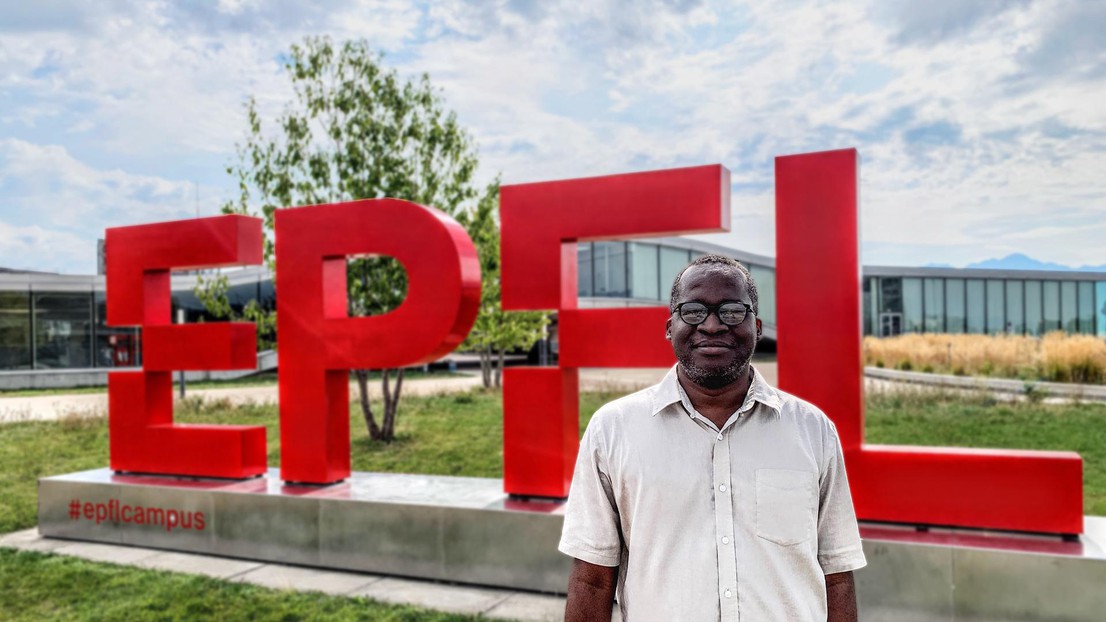Interview of Steve Ndengue, Senior Lecturer at ICTP-EAIFR, Rwanda

© 2022 EPFL
Producing a fuel simply from water and sunlight can seem like a dream, but it’s actually possible. Unfortunately, practical applications are hampered by our limited understanding of the photochemical processes. This is the challenge that Dr. Steve Ndengue and Prof. Marzari from EPFL are taking on with their project on with his project funded by the Junior Faculty Development Programme.
Can you introduce yourself in 2 minutes?
My name is Steve Ndengue. I am a 'Senior Lecturer' at the ICTP-East African Institute for Fundamental Research, a physics institute, which is based in Kigali, Rwanda and is affilated to the University of Rwanda. It is a partner institute of the ICTP (International Center for Theoretical Physics) based in Italy. I dedicate my work to condensed matter topic, with a specific focus on the molecular quantum dynamics. I have a PhD in physics from the University of Grenoble (France) and I was a postdoctoral researcher at the Missouri University of Science and Technology (USA) after having held a faculty position at the University of Douala (Cameroon).
Can you present the scientific collaboration you want to carry out through the JFD programme?
Within the framework of the JFD programme, we plan to work on a project that concerns photocatalysis: catalytic processes initiated by radiation. More specifically, we want to focus on photocatalytic water splitting, a potentially important process for hydrogen production and therefore having environmental and energy applications.
How do you intend to do this?
Our approach is intended to be substantially different from what has been done so far. The molecule of interest here is the water molecule which, due to the presence of hydrogen, has a marked quantum behaviour that influences its macroscopic properties. We therefore want to do as accurately as possible a quantum treatment of the photocatalysis process by numerically "observing" the process from the point of view of a water molecule that is in an environment (solvent) consisting of other water molecules and a catalyst. We will try to follow the catalysis process from this point of view. In parallel, we will try to study the overall process with a molecular dynamics approach by also including quantum effects, again by integrating the solvent. The aim is to learn from these competing views of the process and draw conclusions that could eventually be used for other catalysts and could allow us to learn more about photocatalytic water splitting.
Why did you present a collaborative project with a researcher from EPFL?
EPFL is a world-renowned school and the "co-PI" of this project (Prof. Nicola Marzari) has a worldwide reputation and expertise in the field of condensed matter and more specifically in electronic structure calculations. His input and expertise, as well as that of his team, on certain aspects of the project such as the choice of the appropriate method for computing the electronic interaction will be essential.
Is this the first time you have collaborated with an European university as a professor at the EAIFR?
This is not the first time I have collaborated as an EAIFR researcher with an European university: I currently have related research projects with researchers in France and Germany.
What is the scientific challenge of your research topic?
For this project we have many challenges. One of the main ones will be to describe with high fidelity the electronic interaction, in particular for the characterization of molecular dynamics processes. Subsequently, one of the future challenges will be to either design or suitably adapt molecular quantum dynamical approaches to solve the second part of the problem.
How do you plan to do this?
We have different ideas that we are already exploring. On one hand, as mentioned above, we plan to use computational methods developed in Nicola Marzari's group for this project and combine them with machine learning for the accurate representation of electronic interaction for molecular dynamics calculations. We are also working on novel quantum dynamics approaches for the characterization of high-dimensional processes: we plan to apply these to this study at the appropriate time.
How will this collaboration help to address the scientific challenge described in the previous question?
As mentioned above, we plan to take advantage of the expertise acquired in the partner's team at EPFL to solve some of the questions on electronic interaction which is usually one of the most important aspects of the work. Therefore the contribution of the team at EPFL will be essential.
What does excellence mean to you?
To me, excellence refers to what stands out the rest. In practice and in the context of this programme, I want to associate it with the idea of doing and accomplishing original research that stands out from the others.